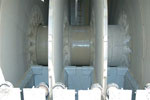
Limestone coming from Metlime's R10m new wash plant, designed by Gauteng engineering firm Thuthuka Group (TGL), is of a far superior quality to that supplied previously. That is the feedback from the wash plant's operator, Jabulanzi, and one of the end-users of the limestone, Zincor. Jabulanzi is TGL's operational arm and assists Metlime in running and maintaining the limestone wash facility.
The innovative limestone wash plant, which utilises a vacuum filter for final washing and drying of the lime mud, was hot commissioned during the weeks prior to 23 August 2006. On this day, the first product fell off the stockpile conveyor and onto the storage slab.
TGL's Francois le Roux says: "The feedback that we received prior to the implementation of the wash plant was that the limestone was full of impurities, more specifically ingress of coarse particles that frequently resulted in outages resulting from pipe blockages."
Metlime receives its lime mud from nearby Sappi Fine Paper's Enstra Mill. This lime mud is then washed, processed by Metlime and sold as metallurgical grade limestone to end users such as Zincor.
"The new wash plant renders limestone void of foreign material and drier than the previous material supplied to Metlime's clients. The product grade is superior to that supplied previously. By virtue of its loose powdery consistency, the material slurries easier than the compacted limestone product supplied before," adds Le Roux.
Now that the plant has commenced processing the lime mud, a six-month window comes into effect during which Metlime, TGL and Sappi will evaluate the plant's performance. During this period, a decision will be made as to whether any retrofits are required to optimise plant performance.
The Metlime Plant
The plant scrubs limestone slurry in a process that displaces the highly soluble sodium ions and incorporates two wash stages.
The first is a contact wash stage where the sodium is transported into a liquid phase by virtue of violent agitation of the lime mud with a low TDS condensate. The sodium, being hydrophilic, remains in the aqueous phase and phase separation is effected through gravity settling. The underflow from the settler is pumped to a ClariDisc vacuum filter and the sodium-rich overflow is combined with vacuum filter filtrate (from further downstream in the process) and pumped back to Sappi.

The second wash phase involves the novel use of a Claridisc vacuum filter in the displacement wash stage.
The limestone slurry is pumped to the vacuum filter vat. The feed solids in this tank are approximately 25% by mass. A number of slow rotating discs are suspended in the vat. Their rotational speed can be adjusted through a variable speed drive. Solids are extracted from the slurry by vacuum and deposited onto the portions of the discs that are submerged in the vat. Lime mud solids are deposited on the filter cloth attached to the outside of each disc. Filtrate is drawn through the filter cloth, into the barrel that supports the discs and through to the vacuum receiver. A thin lime mud pre-coat builds up on the filter cloth and the outer mud layer is continuously shaved off by fixed scraper blades. The dry limestone shavings then fall onto a conveyor that forms the mud transportation system.

When the rotating discs rise out of the vat, air is drawn through the recently deposited solids. This dries the cake to approximately 25% moisture on a mass basis. Cake wash showers located above the vat on the discs' rising side are used for displacement washing of the deposited lime cake.
The vacuum receiver separates air and filtrate. The air is eventually vented to atmosphere at the discharge side of the vacuum pump. A filtrate pump extracts filtrate from the vacuum receiver and pumps it to the filtrate holding tank. From there, filtrate and overflow are pumped back to Sappi.
The five-disc Claridisc vacuum filter can process limestone slurry at the rate of 10 dry tons per hour, with a feed solids consistency of between 20% and 25% by mass. They produce a filter cake with minimum 70-75% dry solids, and yield a 75% wash efficiency.
For more information contact Bill Pullen, Thuthuka, +27 (0)11 466 9788, [email protected], www.thuthukagroup.com

© Technews Publishing (Pty) Ltd | All Rights Reserved